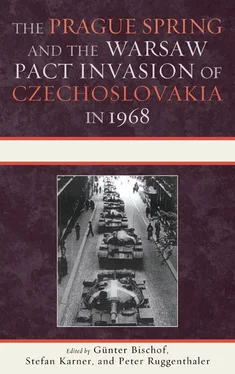Instead, in December 1962 came frost, not spring. Khrushchev personally led the attack against the liberalizing trends and their “agents” in Soviet arts and culture: closing the young artists’ exhibition in the Manege Exhibition Hall near the Kremlin and lashing out at poets and artists at two meetings with the “creative intelligentsia” (December 1962 and March 1963). The accounts, all written from the liberal perspective, blame the crackdown on the “Stalinist conspiracy.” The latest Khrushchev biography cites the leader’s neurotic instability, anti-intellectualism, and flawed vision of reforms and de-Stalinization. This turnabout, however, was totally abrupt and inexplicable for Moscow-based intellectuals and artists, the supporters of cultural liberalization. For a while, they continued to believe that “Stalin stalwarts seemed to be routed completely. One no longer had to fight with them. It was sufficient to laugh them off.” 15Abetted from the top, the crackdown, however, grew into a cultural-ideological backlash, reminiscent both of the Stalinist campaigns of 1946–1949 against “cosmopolitans” and of McCarthyist witch hunts. To many, this campaign also reminded them of a recent public attack on poet Boris Pasternak. Most shockingly, the established Soviet cultural elites, driven by fear and self-protection, became actively engaged in the campaign, denouncing each other, as if there had been no de-Stalinization or revelations by Solzhenitsyn. The momentum of the Moscow Spring was dead. 16
The fragmentation and weakness of public support for cultural liberalization requires us to turn to the divisions, fears, and illusions produced by de-Stalinization in Soviet society, and ultimately to the abortive nature of this de-Stalinization.
LIMITATIONS OF RUSSIA’S DE-STALINIZATION
De-Stalinization was an international phenomenon. In Eastern and Western Europe, Khrushchev’s Secret Speech split the Communist world into “Stalinists” and “reformed Communists.” Numerous people abandoned their Communist beliefs altogether. The Hungarian Revolution was launched by the students and intellectuals who believed in liberalization, but also in “socialism”; their movement was supported by “reformed Communists” in the ruling party. Yet this revolution very quickly developed into an anticommunist, nationalist, anti-Russian movement that “reformed Communists” were unable to control any longer. In Poland, another option prevailed in 1956: ex-Stalinist Władysław Gomułka hoisted himself into the saddle of a popular movement, which blended “reformed communism” with liberalism and heavily anti-Russian Polish nationalism, which was the predominant driving force.
At the risk of crude generalization, the events in Poland and Hungary, as well as in less dramatic ways in Romania, revealed three discourses that emerged in the wake of Stalinism’s “decapitation” by Khrushchev. The Stalinist discourse survived in part as a language of “realism” and cold war, and it remained the language of Communist regimes which stayed in power. These regimes, however, tapped into two other discourses to boost their legitimacy. One was the powerful language of nationalism, both in its liberal and illiberal versions, harking back to earlier collective memories, especially war traumas. Another was an idealistic discourse of reform communism that rejected liberal democracy and economic liberalization as “the return to capitalism” and sought to refurbish and revive the egalitarian promises of the Communist faith, combining them with the dreams of democratization and respect for civil rights.
It is obvious in retrospect that reform communism was a transitional phenomenon on the road from the authoritarian regime toward democratization and full national sovereignty from the Soviet Union. Even before the Prague Spring, the proponents of reformed communism were losing ground everywhere in Eastern Europe either to Stalinists (Poland and Romania of the 1960s) or to radical liberal nationalism (briefly in Budapest in 1956). Yet the mirages associated with reformed communism continued to attract intellectuals and artistic elites everywhere from Moscow to Warsaw and Prague, and from there to Berlin and Paris. The rebellious Zeitgeist of the 1960s in the West, especially the continued ideological fascination with Karl Marx, Vladimir Lenin, and Mao Zedong among Western intellectuals and students, supported and nourished these illusions and spread them among millions of believers in the rapidly growing ranks of university students and the professional middle classes. 17
De-Stalinization proceeded very differently in various regions of the Soviet Union. In the Baltic republics, Ukraine, and in South Caucasus, especially in Georgia, the nationalist discourse was predominant. In Soviet Russia, it was a more complicated and contradictory process. The crisis of 1956 had already revealed important things about Russian Soviet society. The shock of revelations of Stalin’s crimes created the possibility for spiritual catharsis, for self-questioning. Some Moscow intellectuals, scientists, and students perceived themselves as a vanguard of de-Stalinization from below. Very few of them were ready, however, to question the entire revolutionary legacy. It was customary among intellectual hot-heads to rediscover the traditions of the Russian struggle against the Tsarist autocracy. Reformed communism contrasted “moral” Bolshevism with Stalinism, thereby preserving the basic myth of the leftist intelligentsia about its special mission in remaking and saving Russia. Poet David Samoilov wrote in his diary in 1957 that Stalin brought to power meschanstvo , the anti-intellectual lower-middle class, the embodiment of provincial darkness and crass materialism; the task of the intellectuals was to fight against this group. 18This line of thinking is typical of the time.
Just like many liberal-minded and reform-Communist intellectuals in Central Europe then and later, many of the anti-Stalinist intellectuals in Moscow came from the families of Old Bolsheviks and passionate believers in the revolution. Most of them still thought that a “return to Lenin” and “purification” of the revolutionary cause from Stalinism was the correct path to the future. For a decade after 1956, some of them would search for “a flaw in the original design” of Marxism in history, philosophy, sociology, and political economy. Others would propagate the idea of genuine revolution and honest and moral revolutionaries including Lenin (as opposed to Stalin and Stalinists) in theater, cinema, art, and literature. 19
At the same time, in contrast to Central Eastern Europe, the Russian Soviet society failed to develop a potent nationalist alternative to discredited Stalinism. In part, this incapacity was the reflection of Russian history, traditions, and the composition of society. Unlike the Hungarians in 1956 and the Czechs in 1968 who remembered life before “communization,” the vast majority of Russians in 1956 and later remembered only the Soviet past. In Budapest and Prague, there were deep-seated liberal traditions and culture rooted in historical memories and the recently destroyed bourgeois, middle-class milieu. Virtually none of these existed in Moscow or elsewhere in Russia by 1953. Stalinism had reshaped and debased Russian society more than the societies of Central Europe. In Leningrad, the only truly European city of Russia, the bourgeois-liberal milieu had been destroyed by waves of terror and resettlements. In Moscow, numerous members of the cultural elites enjoyed in some ways bourgeois and middle-class standards of life, yet they developed the ingrained “court” mentality of time-serving cynics. Many of them fully accepted their role as the servants of the regime and abdicated their spiritual and moral responsibilities to society. They were prepared to stamp out any heretics and revisionists that dared to break the rules and cross the boundaries of the permissible. In 1958–1959, these “court” cultural elites, unleashed by the Kremlin, hunted down poet Boris Pasternak after he published his novel Doctor Zhivago (treating the Russian revolution as a deeply tragic, rather than historically progressive development) abroad and received the Nobel Prize for literature. Later, in 1963–1965, they supported repression against their fellow poets, writers, and filmmakers.
Читать дальше












